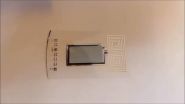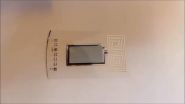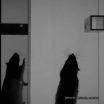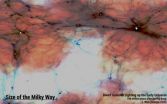(Press-News.org) VIDEO:
The video shows how a printed label picks up the radio signal from a telephone making a call, and uses the energy to switch the integrated display. This is only...
Click here for more information.
With an article published in the Proceedings of the National Academy of Sciences in the United States of America (PNAS), a thirteen-year-long mystery that has involved a long series of researchers at both Linköping University and Acreo Swedish ICT has finally been solved.
The article presents a diode in printed electronics that works in the GHz band, which opens up a new opportunity to send signals from a mobile phone to, for example, printed electronic labels. Energy from the radio signal is collected and used to switch the label's display. The diode being printed means that it is both cheap and simple to manufacture.
"This means that we can supply power to printed electronics within the 'internet of things' with the help of conventional mobile phones. This gives us new opportunities for communications," says Negar Sani, PhD student at the Laboratory for Organic Electronics at Linköping University.
Researchers have long known that the diode works, but not how and why.
In 2001, Petronella Norberg at Acreo Swedish ICT, laid a disc of silicon in a mortar, ground it down and produced a silicon paste that she then used as ink in a printing press. She produced a functional printed diode – the electronic key component that, among other things, converts alternating current to direct current. But the diode only worked up to 1 MHz, and no immediate field of use could be found.
At Acreo Swedish ICT, a research team funded by the British company De La Rue, worked for several years on developing both the diode and new printing pastes. With a paste containing the transition metal niobium, in the form of niobium silicide, NbSi2, printed over the silicon paste, they got the whole thing to work at GHz as well.
"The results meant a world record for printed diodes, and we were also able to manufacture a demonstrator for De La Rue where the signal from a mobile phone was used to activate a printed display. We had demonstrated that it was possible to link paper to the Internet," says Göran Gustafsson, department head at Acreo Swedish ICT.
But still nobody knew how the diode worked.
Ms Sani has now taken the last decisive step toward solving the puzzle, naturally with the help of Professors Magnus Berggren and Xavier Crispin as well as Senior Lecturer and Project Manager Isak Engquist, and a number of people at Acreo Swedish ICT. The results of Ms Sani's work showed that it must have to do with tunnel effects, a phenomenon in quantum physics that makes it so that particles can get past obstacles. In this case, nano-thin films (1–2 nm) are formed around the micrometer-sized grains of silicon, where the current between anodes (aluminium) and cathodes (silver and carbon) pass through, but only in one direction.
Thirteen years of work got an explanation – one that the editorial board of PNAS finally approved after more than five months of hard review by experts from various fields.
"This is the longest project I've worked on. What research sponsor wants to wait 13 years for publication? Without industry – De La Rue, in this case – we'd never have come this far. Now printed electronics are starting to get the same performance as traditional electronics, and this is another example of the fruitful combination of our research, developments at Acreo and needs from the industry," says Magnus Berggren, professor of Organic Electronics at Linköping University.
INFORMATION:
Contact:
Negar Sani, negar.sani@liu.se, +46 11 363467
Magnus Berggren, magnus.berggren@liu.se +46 11 363637
Negar Sani solved the mystery of the printed diode
2014-07-07
ELSE PRESS RELEASES FROM THIS DATE:
Neuroeconomists confirm Warren Buffett's wisdom
2014-07-07
Investment magnate Warren Buffett has famously suggested that investors should try to "be fearful when others are greedy and be greedy only when others are fearful."
That turns out to be excellent advice, according to the results of a new study by researchers at Caltech and Virginia Tech that looked at the brain activity and behavior of people trading in experimental markets where price bubbles formed. In such markets, where price far outpaces actual value, it appears that wise traders receive an early warning signal from their brains—a warning that makes them feel uncomfortable ...
Smart and socially adept
2014-07-07
Wanted: Highly skilled individual who is also a team player. In other words, someone who knows his or her stuff and also plays well with others.
Two qualities are particularly essential for success in the workplace: book smarts and social adeptness. The folks who do well tend to demonstrate one or the other. However, according to research conducted by UC Santa Barbara economist Catherine Weinberger, the individuals who reach the highest rungs on the corporate ladder are smart and social. Her findings appear in a recent online issue of the Review of Economics and Statistics.
Weinberger, ...
The tortoise and the hare: A sex difference in marathon pacing
2014-07-07
ALLENDALE, Mich. — Men are more likely than women to slow their pace in the marathon, according to a new study led by a Grand Valley State University researcher. The findings were published in Medicine & Science in Sports & Exercise.
The study, led by Robert Deaner, associate professor of psychology at Grand Valley State, was based on 14 marathons that occurred in the U.S. in 2011, and it included almost 92,000 performances. On average, men ran the second half of the marathon 15.6 percent slower than the first half, whereas women slowed by an average of 11.7 percent. ...
Slim down for the health of it and possibly reduce your hot flashes in the process
2014-07-07
CLEVELAND, Ohio (July 7, 2014)—Now women have yet one more incentive to lose weight as a new study has shown evidence that behavioral weight loss can help manage menopausal hot flashes.
The pilot study, which was published online last month in Menopause, the journal of The North American Menopause Society (NAMS), consisted of 40 overweight or obese white and African-American women with hot flashes, which are the most prevalent symptom of menopause. In fact, more than 70% of women report hot flashes during the menopausal transition, with many of these women reporting frequent ...
US scientists don't publish articles about potential role of innate variation in athletic performance
2014-07-07
ALLENDALE, Mich. — Compared to scientists working in other countries, U.S.-based scientists are underrepresented as authors of articles on the potential role of innate variation in athletic performance that are published in peer-reviewed science journals, according to Grand Valley State University researchers.
The findings are published in the online journal SpringerPlus.
The research, conducted by Michael P. Lombardo, professor of biology, and Shadie Emiah, a Grand Valley State graduate student, used information about the authors of 290 articles published in peer-reviewed ...
Of non-marijuana drug users in the ER, nearly all are problem drug users
2014-07-07
WASHINGTON —Of emergency patients who reported any drug other than marijuana as their primary drug of use, 90.7 percent met the criteria for problematic drug use. Among patients who reported cannabis (marijuana) as their primary drug, almost half (46.6 percent) met the criteria for having a drug problem, according to a study published online Thursday in Annals of Emergency Medicine ("Identifying Patients with Problematic Drug Use in the Emergency Department: Results of a Multi-Site Study.)
"Of patients who reported any drug use in the previous 30 days, nearly two-thirds ...
Sitting too much, not just lack of exercise, is detrimental to cardiovascular health
2014-07-07
Dallas – July 7, 2014 – Cardiologists at UT Southwestern Medical Center found that sedentary behaviors may lower cardiorespiratory fitness levels. New evidence suggests that two hours of sedentary behavior can be just as harmful as 20 minutes of exercise is beneficial.
The study, published in today's online edition of Mayo Clinic Proceedings, examined the association between fitness levels, daily exercise, and sedentary behavior, based on data from 2,223 participants in the National Health and Nutrition Examination Survey (NHANES).
Sedentary behavior involves low levels ...
Rats purposefully use their whiskers in different ways to help navigate in the dark
2014-07-07
VIDEO:
This is an example of the use of the whiskers for collision avoidance. Unexpected whisker contact
results in rapid deceleration of forward locomotion velocity and the animal orients to the...
Click here for more information.
The way rats use their whiskers is more similar to how humans use their hands and fingers than previously thought, new research from the University of Sheffield has found.
Rats deliberately change how they sense their environment using their ...
Small, but plentiful: How the faintest galaxies illuminated the early universe
2014-07-07
Light from tiny galaxies over 13 billion years ago played a larger role than previously thought in creating the conditions in the universe as we know it today, a new study has found. Ultraviolet (UV) light from stars in these faint dwarf galaxies helped strip interstellar hydrogen of electrons in a process called reionization.
The epoch of reionization began about 200 million years after the Big Bang and astrophysicists agree that it took about 800 million more for the entire universe to become reionized. It marked the last major phase transition of gas in the universe, ...
NASA satellites see Neoguri grow into a super typhoon
2014-07-07
From July 4 to July 7 Tropical Cyclone Neoguri strengthened from a tropical storm into a supertyphoon. NASA's Terra and Aqua satellites passed over the rapidly intensifying storm and provided forecasters with visible, infrared and microwave data on the powerful supertyphoon.
On July 4 at 0900 UTC (5 a.m. EDT) Neoguri had maximum sustained winds near 55 knots (63.2 mph/101.9 kph). It was located near 13.1 north and 141.4 east, about 207 nautical miles (238.2 miles/383.4 km) west of Andersen Air Force Base, Guam. It was moving to the northwest at 13 knots (14.9 mph/24.0 ...






